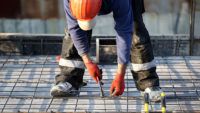Tool tethering is key to protect yourself and others

Photo credit: PK Safety
Falling tools can injure workers when dropped from elevated surfaces, even if those workers are wearing hard hats. Something as light as a wrench can reach a speed of nearly 80 miles per hour if it falls 200 feet straight down. That’s why workers and employers need to take steps to protect portable tools from falling over the edge of the worksite. Workers must tether tools to the elevated surface, so they can’t fall to lower/ground levels. Tethering tools will also improve workplace efficiency by increasing the accessibility of the equipment. Workers don’t have to go out of their way when looking for essential items. They can follow the tether to locate the tool as quickly as possible.
How to tether tools in the workplace
Dropped object prevention is about finding a way to prevent tools from falling from elevated surfaces. Anything from a small tool or several screws too close to the edge of a high surface can become a dropped object if it’s accidentally knocked over or blown by the wind to a lower level. Other dropped object hazards can include items stored in pockets, pouches, or bags that may not be securely fastened. Items that have direct impacts can fall at fatal speeds. Falling tools can also deflect off other surfaces or objects, causing the tool to bounce out of a designated “Drop Zone”—an area designed to keep workers and anyone outside of an at-height work area safe.
The easiest way to tether a tool is to use one with a built-in attachment point. Tethering tools are known as “tether ready,” but the attachment point must be load-rated for the total tool weight to ensure the tether can support the weight.
Attachment points can include D-ring cords, D-ring and quick-wrap tape, and tool cinch attachments. The attachment point must connect to an anchorage point using a lanyard or self-retracting lifeline, which will catch the tool if it falls.
Attach tools over five pounds to a fixed anchorage point on the elevated surface. If the tool is less than five pounds, it can be tethered to a tool belt, belt loop, holster, or wristband.
Workers and construction companies should do their best to use tether-ready tools when working on elevated surfaces to prevent injuries. You can add a built-in attachment point to the tool if it doesn’t have one, or the team should use an alternative tool.
Having a good grip on the tool also prevents slips and falls. Workers should use gloves with reinforced grips to keep the tool in their hands.
Employers need to train workers on how to tether their tools properly. They should also post signs reminding crews to attach tools before starting work. Everyone should take the time at the start of each shift to inspect the lanyards and attachment points to ensure they are intact. Lanyards should be replaced if they appear frayed or weak. Mount the lanyard to the tool with a carabiner or metal clip.
Keeping tools tethered is a must in high-risk industries that use tools and equipment in areas where they could fall. Workers must also wear hard hats in these environments to protect themselves from head injuries.
Working in high areas increases the risk of falling objects. Construction and utility repair crews can refer to this information to improve accuracy and workplace safety.
Looking for a reprint of this article?
From high-res PDFs to custom plaques, order your copy today!








